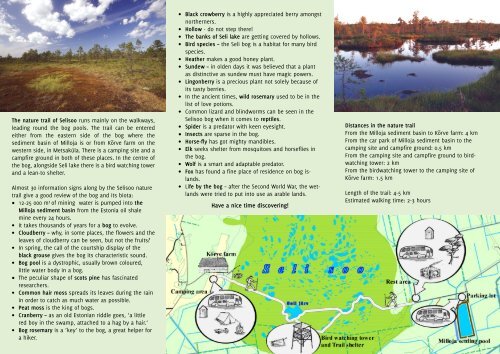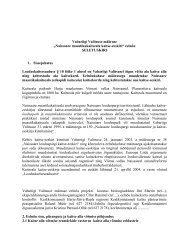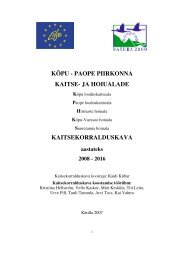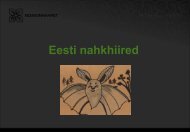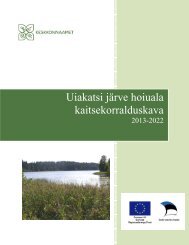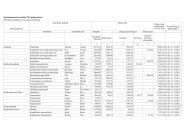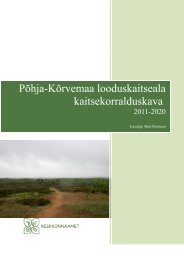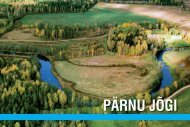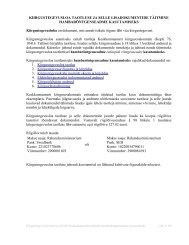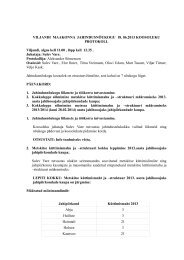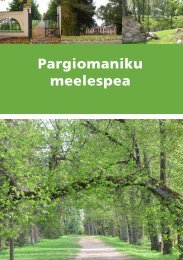The nature trail of Selisoo - Keskkonnaamet
The nature trail of Selisoo - Keskkonnaamet
The nature trail of Selisoo - Keskkonnaamet
You also want an ePaper? Increase the reach of your titles
YUMPU automatically turns print PDFs into web optimized ePapers that Google loves.
<strong>The</strong> <strong>nature</strong> <strong>trail</strong> <strong>of</strong> <strong>Selisoo</strong> runs mainly on the walkways,<br />
leading round the bog pools. <strong>The</strong> <strong>trail</strong> can be entered<br />
either from the eastern side <strong>of</strong> the bog where the<br />
sediment basin <strong>of</strong> Milloja is or from Kõrve farm on the<br />
western side, in Metsaküla. <strong>The</strong>re is a camping site and a<br />
campfi re ground in both <strong>of</strong> these places. In the centre <strong>of</strong><br />
the bog, alongside Seli lake there is a bird watching tower<br />
and a lean-to shelter.<br />
Almost 30 information signs along by the <strong>Selisoo</strong> <strong>nature</strong><br />
<strong>trail</strong> give a good review <strong>of</strong> the bog and its biota:<br />
• 12-25 000 m3 <strong>of</strong> mining water is pumped into the<br />
Milloja sediment basin from the Estonia oil shale<br />
mine every 24 hours.<br />
• It takes thousands <strong>of</strong> years for a bog to evolve.<br />
• Cloudberry – why, in some places, the fl owers and the<br />
leaves <strong>of</strong> cloudberry can be seen, but not the fruits?<br />
• In spring, the call <strong>of</strong> the courtship display <strong>of</strong> the<br />
black grouse gives the bog its characteristic sound.<br />
• Bog pool is a dystrophic, usually brown coloured,<br />
little water body in a bog.<br />
• <strong>The</strong> peculiar shape <strong>of</strong> scots pine has fascinated<br />
researchers.<br />
• Common hair moss spreads its leaves during the rain<br />
in order to catch as much water as possible.<br />
• Peat moss is the king <strong>of</strong> bogs.<br />
• Cranberry – as an old Estonian riddle goes, ‘a little<br />
red boy in the swamp, attached to a hag by a hair.’<br />
• Bog rosemary is a ’key’ to the bog, a great helper for<br />
a hiker.<br />
• Black crowberry is a highly appreciated berry amongst<br />
northerners.<br />
• Hollow - do not step there!<br />
• <strong>The</strong> banks <strong>of</strong> Seli lake are getting covered by hollows.<br />
• Bird species – the Seli bog is a habitat for many bird<br />
species.<br />
• Heather makes a good honey plant.<br />
• Sundew – in olden days it was believed that a plant<br />
as distinctive as sundew must have magic powers.<br />
• Lingonberry is a precious plant not solely because <strong>of</strong><br />
its tasty berries.<br />
• In the ancient times, wild rosemary used to be in the<br />
list <strong>of</strong> love potions.<br />
• Common lizard and blindworms can be seen in the<br />
<strong>Selisoo</strong> bog when it comes to reptiles.<br />
• Spider is a predator with keen eyesight.<br />
• Insects are sparse in the bog.<br />
• Horse-fl y has got mighty mandibles.<br />
• Elk seeks shelter from mosquitoes and horsefl ies in<br />
the bog.<br />
• Wolf is a smart and adaptable predator.<br />
• Fox has found a fi ne place <strong>of</strong> residence on bog islands.<br />
• Life by the bog – after the Second World War, the wetlands<br />
were tried to put into use as arable lands.<br />
Have a nice time discovering!<br />
Distances in the <strong>nature</strong> <strong>trail</strong><br />
From the Milloja sediment basin to Kõrve farm: 4 km<br />
From the car park <strong>of</strong> Milloja sediment basin to the<br />
camping site and campfi re ground: 0.5 km<br />
From the camping site and campfi re ground to birdwatching<br />
tower: 2 km<br />
From the birdwatching tower to the camping site <strong>of</strong><br />
Kõrve farm: 1.5 km<br />
Length <strong>of</strong> the <strong>trail</strong>: 4-5 km<br />
Estimated walking time: 2-3 hours
Distances<br />
Metsküla – Mäetaguse: 7 km<br />
<strong>The</strong> Milloja sediment basin – Jõhvi-Tartu highway: 3 km<br />
<strong>The</strong> Milloja sediment basin – Iisaku: 15 km<br />
<strong>The</strong> Milloja sediment basin – Mäetaguse: 11 km<br />
Mäetaguse – Jõhvi: 20 km<br />
Jõhvi 20 km<br />
<strong>The</strong> administrator <strong>of</strong> the <strong>nature</strong> area:<br />
<strong>The</strong> Environmental Board,<br />
Region <strong>of</strong> Viru<br />
Pargi 15, Jõhvi<br />
41537, Ida-Virumaa County<br />
Estonia<br />
Phone: +3723324401<br />
E-mail: ida-viru@keskkonnaamet.ee<br />
Homepage: www.keskkonnaamet.ee<br />
Nature <strong>trail</strong> manager:<br />
RMK, <strong>The</strong> Nature Centre <strong>of</strong> Kauksi<br />
Kauksi, Iisaku Parish<br />
41008, Ida-Virumaa County<br />
Estonia<br />
Phone: +3723393833<br />
E-mail: kauksi.looduskeskus@rmk.ee<br />
Homepage: www.rmk.ee<br />
Editor: Ingrid Kuligina<br />
Images: Jürgen Öövel, Raili Lille<br />
Designer: Kalle Raidma<br />
Printer: Folger Art AS<br />
Publisher: <strong>The</strong> Environmental Board<br />
Financier: <strong>The</strong> Foundation <strong>of</strong> the<br />
Environmental Investment Centre<br />
<strong>The</strong> Nature Trail <strong>of</strong><br />
<strong>Selisoo</strong><br />
<strong>The</strong> Natura 2000 site in <strong>Selisoo</strong> is valued for<br />
both the forested and nonforested raised<br />
bogs and transitional bog forests.


